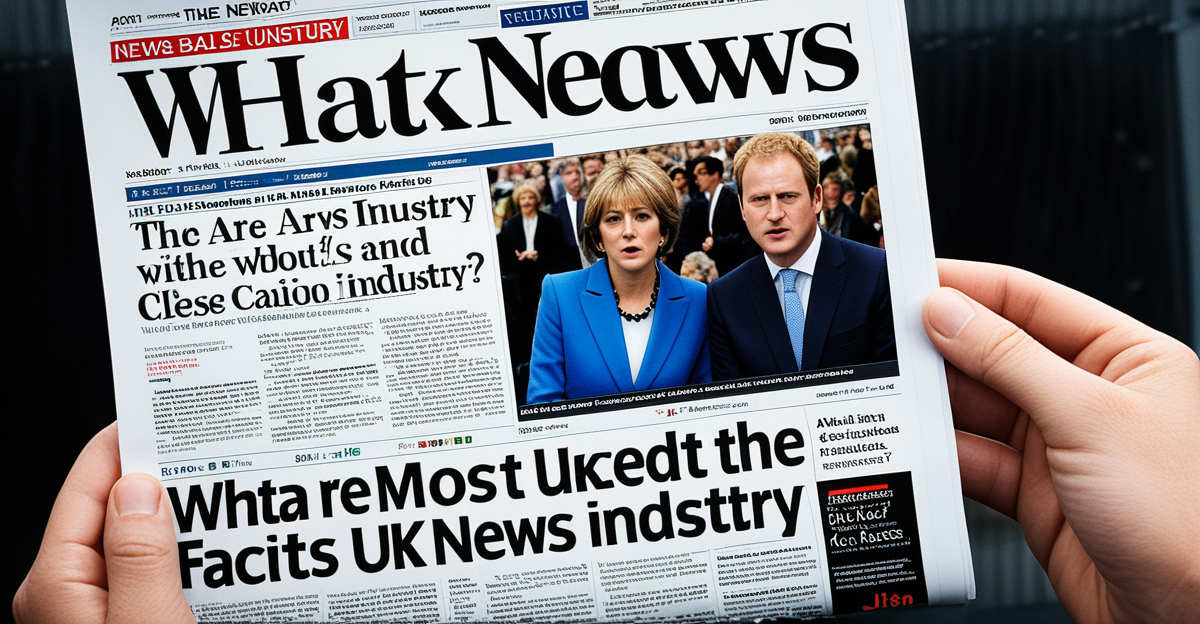Hidden Histories and Unusual Origins in the UK News Industry
The history of UK news is marked by remarkable firsts, notably with the launch of the world’s first daily newspaper in London during the early 18th century. This pioneering spirit laid crucial groundwork for the UK’s enduring influence on global media. Several publishing milestones trace back to these early efforts, such as innovations in printing and distribution methods that transformed how news reached the public.
Wartime censures during both World Wars introduced a complex dynamic in the UK’s press. Secret operations and clandestine publications played a crucial role, illustrating the media’s adaptability under strict government oversight. This era also shows how the industry’s commitment to informing its audience persisted despite heavy constraints.
This might interest you : Why Are Community Leaders Pushing for Change in Britain’s Local Governments?
Interestingly, the UK newspapers origin often ties to moments of serendipity. For example, some leading newspapers emerged from chance discoveries or unexpected mergers, highlighting how accidental events shaped the industry’s evolution. These unusual origins contribute to the rich tapestry of UK journalism, emphasizing resilience and innovation amid uncertainty.
Unexpected Industry Statistics and Pressures
The UK news industry statistics reveal a dramatic shift from traditional print to digital consumption. Over recent years, newspaper circulation of physical copies has steadily declined, reflecting changing readership trends. For instance, daily print runs for many UK papers have dropped by over 40% in just a decade. Meanwhile, digital-only readership has surged, with many consumers preferring online platforms for its immediacy and accessibility.
This might interest you : How are UK schools integrating technology in education?
Interestingly, unusual readership demographics have emerged. Younger audiences now dominate digital news consumption, while older generations still prefer print versions. This split creates significant challenges for publishers as they try to balance legacy print operations with growing digital demands. Additionally, engagement patterns differ: digital readers often skim articles, requiring newsrooms to innovate with formats such as short videos, interactive content, and newsletters to retain attention.
These pressures compel the UK news industry to continually adapt. Publishers invest heavily in analytics to track reader behavior, tailoring content to maintain loyalty. The future of UK news hinges on managing this delicate transition, ensuring that both print and digital audiences are served efficiently without compromising journalistic quality or financial viability.
Hidden Histories and Unusual Origins in the UK News Industry
Hidden within the history of UK news are remarkable stories of chance and innovation that forged its path. The UK boasts the world’s first daily newspaper, launched in the early 1700s, marking a significant publishing milestone. This innovation set a precedent, altering how news was processed and consumed globally.
Wartime censorship deeply influenced the UK news landscape. During both World Wars, strict government controls led to secret press operations and underground publications that bypassed official oversight. These covert efforts not only sustained public morale but also underscored the resilience of UK newspapers despite severe restrictions. Such developments are pivotal yet often overlooked chapters in the history of UK news.
The UK newspapers origin is also entwined with unusual, often accidental events. Some leading newspapers emerged from unexpected mergers or chance discoveries—instances that seemed coincidental but had lasting impacts. These stories reveal how adaptability and opportunism shaped significant publishing milestones, highlighting the unpredictable nature of the industry’s evolution. Together, these elements expose the rich, complex tapestry behind the UK’s press history.
Regulatory Quirks and Legal Oddities
The UK media regulation system stands out for its distinctive frameworks that both protect and challenge press freedom. Unlike many countries, the UK operates under a unique model combining statutory oversight, such as the Royal Charter on self-regulation, with voluntary bodies like the Independent Press Standards Organisation. This dual approach often leads to nuanced tensions in enforcing news industry rules.
One notable quirk involves the Press Complaints Commission’s historical role. Although it aimed to handle complaints efficiently, critics argued it lacked independence, prompting reforms that redefined how press freedom laws apply. The Royal Charter, introduced to reinforce ethical journalism, balances safeguarding publishers and maintaining public trust, yet it also raises complex debates about censorship versus accountability.
Lesser-known legal battles have significantly shaped reporting standards. Cases involving libel, privacy, and contempt laws forced media outlets to refine editorial practices. For example, high-profile lawsuits compelled newspapers to improve fact-checking and source verification, thus influencing the broader UK media regulation landscape. These regulatory peculiarities underscore the ongoing struggle to uphold press freedom while ensuring responsible journalism within the UK’s evolving legal context.
Regulatory Quirks and Legal Oddities
The UK media regulation landscape is distinctive, shaped by frameworks that both protect and challenge press freedom. Central to this is the Royal Charter, a unique instrument established to oversee press standards independently. Unlike many countries, this system combines government-endorsed regulation with voluntary press adherence, engendering debates about its effectiveness and impact on editorial independence.
The Press Complaints Commission (PCC), predecessor to the current Independent Press Standards Organisation, introduced peculiar mechanisms for handling complaints. Although designed to empower the public, its voluntary nature often limited enforcement, leading to criticisms regarding impartiality and its influence on press conduct.
Press freedom laws in the UK offer robust protections but come with complex obligations. For example, defamation laws and contempt of court regulations impose strict boundaries on reporting, requiring journalists to navigate legal nuances carefully to avoid litigation. These legal oddities shape how stories are pursued and presented.
Some lesser-known legal battles have set important precedents, refining journalist protections and defining the limits of public interest. Such cases illustrate how news industry rules evolve, balancing freedom with responsibility, and demonstrate the UK’s ongoing efforts to adapt due to both technological changes and societal expectations.
Hidden Histories and Unusual Origins in the UK News Industry
The history of UK news begins proudly with the launch of the world’s first daily newspaper in London in the early 1700s, marking a crucial publishing milestone. This pioneering effort not only revolutionized news delivery but cemented the UK’s role in global journalism. The early print runs were modest but set standards for regular, accessible news.
Wartime censorship significantly shaped the UK press during both World Wars. Strict government controls led to secret press operations—clandestine publications that defied official restrictions to inform and bolster public morale. These covert activities reveal how resilience and innovation were vital components in the UK newspapers origin, displaying adaptability amid pressure.
Accidental events also influenced many leading news institutions. Newspapers often arose from unexpected mergers or chance discoveries, demonstrating that the industry’s roots are intertwined with coincidence and opportunism. Such odd occurrences reshaped trajectories, creating pivotal publishing milestones whose impacts lasted centuries. Together, these layers reveal a nuanced and multifaceted history of UK news that blends pioneering ambition with unforeseen twists.
Hidden Histories and Unusual Origins in the UK News Industry
The history of UK news boasts the launch of the world’s first daily newspaper in London, a groundbreaking publishing milestone that shaped global journalism’s trajectory. This early development positioned the UK as a pioneer, setting standards still influential today.
Wartime censorship imposed severe constraints but also sparked secret press operations. These clandestine publications bypassed official control during both World Wars, serving as critical sources of information and morale. This reveal in the history of UK news underscores resilience under pressure, highlighting how the press adapted in extraordinary circumstances.
Unexpected occurrences played a defining role in the UK newspapers origin. Some of today’s leading newspapers arose from accidental mergers and chance discoveries rather than planned strategies. These fortuitous events illustrate the unpredictable nature of the industry’s evolution, emphasizing flexibility and innovation as essential traits.
Together, these layers of hidden histories reveal a complex foundation beneath the familiar surface of UK journalism. By examining the history of UK news, the UK newspapers origin, and key publishing milestones, one gains insight into an industry shaped by both intent and serendipity, continually evolving through challenges and change.
Hidden Histories and Unusual Origins in the UK News Industry
The history of UK news famously begins with the establishment of the world’s first daily newspaper in London during the early 1700s. This revolutionary publishing milestone set a global standard for regular news dissemination, advancing the accessibility and reliability of printed information. The UK’s pioneering role in creating daily news marked a significant departure from less frequent bulletins, ultimately shaping modern journalism.
During both World Wars, wartime censorship heavily influenced the UK press. These periods saw the rise of secret press operations—clandestine publications that navigated strict government controls to keep the public informed. These covert efforts not only preserved critical communication channels but also illustrated the press’s resilience under duress, fundamentally impacting the UK newspapers origin story.
Equally compelling is the role of accidental discoveries and unforeseen mergers in forming major newspapers. Many leading institutions owe their beginnings to chance events and peculiar coincidences. Such moments, though seemingly incidental, led to significant publishing milestones that redirected the industry’s landscape, reinforcing the unpredictable nature embedded in the history of UK news. This blend of innovation, secrecy, and happenstance underpins the rich, layered origins of UK journalism.
Hidden Histories and Unusual Origins in the UK News Industry
The history of UK news is deeply anchored in its pioneering launch of the world’s first daily newspaper in London in the early 1700s, a defining publishing milestone that set the foundation for modern journalism globally. This breakthrough introduced regular, reliable news dissemination, vastly transforming information consumption at the time.
A crucial factor shaping the UK newspapers origin was the impact of wartime censorship during both World Wars. Strict government controls led to secret press operations—clandestine publications produced to circumvent official restrictions. Such covert efforts ensured communication channels remained open, preserving public morale and demonstrating resilience within the industry during periods of intense scrutiny and limitation.
Accidental events also played a significant role in the evolution of major UK news institutions. Many newspapers owe their emergence to fortuitous mergers or chance discoveries rather than deliberate planning. These odd coincidences often resulted in unexpected publishing milestones that altered the trajectory of UK journalism. This blend of innovation, secrecy, and serendipity illuminates the complex and multifaceted nature of the UK news industry’s origins.








